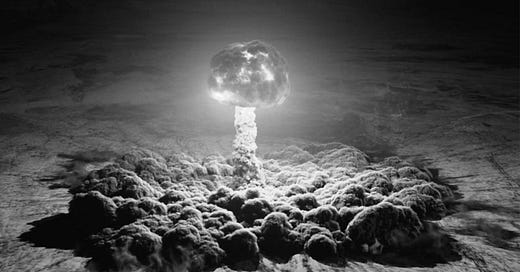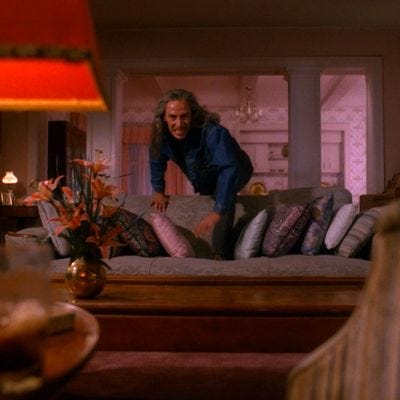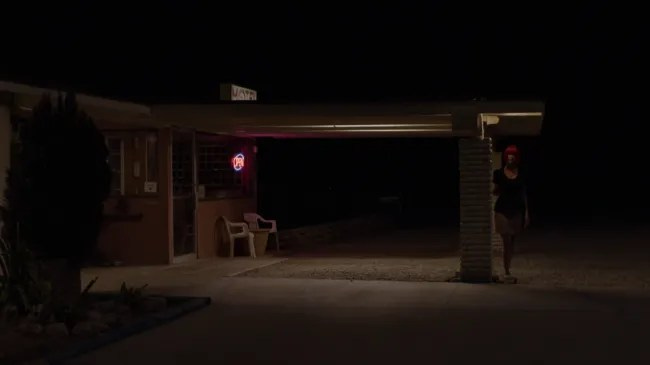This piece was originally published with some modifications on Tuesday, January 28, 2025 by IM-1776.
There is a poetic not justice, but balance, to how David Lynch came to be the emblematic casualty of the LA fires. Never outfoxed, he was somehow outsmoked by a lethal injection of poisons the description of which reads like a postapocalyptic terraformer’s almanac: fine particulate dark matter; the amoebulae of VOCs; destructive debris of construction materials; furans and dioxins; heavy metals spat like microspores and shrapnel from the death throes of some fourteen thousand structures, mostly homes; with a nimbus of carbon monoxide to garnish the smelt of innumerable lithium-ion batteries.
It is as if the burning of the Library of Alexandria had been re-enacted in one man for our limited time only. Pedants will say, actually, the Library at Alexandria didn’t contain much that couldn’t be found elsewhere, while missing the point. Some losses are cultural watersheds, and Lynch’s death—like that of his collaborator David Bowie in 2016—is exactly that: a terminus past which the future of an artform, and with it, that of a certain form of life, become irreproducible forever. In Lynch’s case, we are fortunate most of his archive survives and is correctly assessed as invaluable. We did not, as with Gary Indiana’s ill-fated collection or the annals of the Theosophical Society, lose The Work. So what we are mourning is, in possibility and actuality, The Man, and the shared pain over his passing singles him out among the few remaining vectors of consensus in the opus nigrum of our culture: we can agree to disagree on anything but David Lynch.
Though it is possible he will become increasingly inscrutable to all but our sharpest descendants, since his work demands the sort of skills spectatorship no longer cultivates—attention, intention, patience, presence, a tolerance for ambiguity, underinvestment in ‘plot’ and its ‘holes’, a sense of embodiment—the consistent or more communicable aspects of his language—those that fall under the tired but needed catchall ‘Lynchian’—will subsist in myriad ways. The Lynchian is inscribed within the fabric of our lives because it is that very fabric, and we begin to know it once we start to see it. In this sense, Lynch’s oeuvre is a fieldguide to ‘seeing-as’, the Wittgensteinian technique for the juicing of extraordinary insight out of ordinary language. Like no other artist before him, Lynch pulled duck-rabbits out of his splendid hat of hair.
In Lynch we lost a maharishi, and it isn’t farfetched to say that his body of work—and not just in film—can be interpreted as an American Upanishad. The way he saw (and, effectively, heard) around corners is perhaps only comparable to James Joyce’s unfiltered surfacing of interiority through stream-of-consciousness, though Lynch cast us loose into what he described as that consciousness’ ‘ocean’—a space even more difficult to navigate. All creatures are one with the flow, and some are aware of it. With this awareness comes the recognition that one is immersed within a larger cosmic current, though separate enough from it as to observe it; to surrender to it or resist its force. Though neither a means of escape nor control, it bestows those aware with a sense or measure of autonomy or self when faced with the irresistible, the impenetrable, and the ineffable.
This is very much why Twin Peaks, Lynch’s genre-bending masterpiece, is a whatisit and not a whodunnit. It is not incidental that Dale Cooper, its protagonist, is an agent, and that his quest—if that is what it should be called—is a persistent affront to that agency. By the end of The Return, when he has crossed into the trap world of ‘Odessa’ as a reintegrated-yet-diminished concentrate of himself, he is practically stripped of any drive that doesn’t correspond with duty. As a dharmic figure, his arc leans towards a submission to fate, freely undertaken. His sole remaining raison d’être is correcting the perhaps incorrigible situation dictated by Laura Palmer’s karma and, in this attempt, he appears to transcend traditional heroism and conventional identity to reach a state that cannot be defined by any of his previous roles as agent, man, or even human. Tat tvam asi.
The evil Lynch dealt with was the Real. It was not imaginary nor symbolic, but a plenum, and, like Blake—the Western artist he may best resemble—Lynch commanded his full powers as a medium with a mastery of many media to go angling in the immanent. Evil is neither outside nor below, it is intrinsic, in the same way Good is intrinsic. Lynch does not invite us to see past the surface so much as into it—such is the essence of the famous scene where Sarah Palmer first sees BOB—and if Blake’s conceptualization of good and evil as different modes of consciousness resonates with Lynch’s, it’s because the two suggest creation and destruction share a source. The implication is that evil and, by extension, good are emergent properties of reality.
In The Marriage of Heaven and Hell, Blake declares that “evil is the active springing from energy”, and the Trinity Test scene in The Return hews to this notion. The atomic blast is a Big Bang of creative-destruction that unleashes maya in its utmost violence: the devouring mother Jowdy (Judy) and her ‘son’, the karmic vampire BOB, who align with concepts like avidya (ignorance) or mahavidya (great illusion), that obscure the truth and keep souls ensnared in the cycle of samsara. But if the birth of the nuclear age acts as the catalyst for the appearance of Evil as ‘experiment’, it also causes the equal and opposite inception of Good as its containment strategy and cosmic lure: The Fireman and Seorita Dido eject the golden orb containing scapegoat-savior Laura into the world. The energy released by these events has the momentum to influence everything downwind from it.
Among the fatal outcomes of the nuclear explosion is the infection and the subsequent nuclear implosion of the Palmer family. By positioning Jowdy as Laura’s mother and BOB as the force possessing her father, the home becomes a charnel house. Avidya and mahavidya are at their deadliest when they masquerade as the familiar, and so the family is debased into a theatre of samsara's pitfalls: denial, trauma, and abuse. House Palmer thus becomes the ultimate enclave of karmic reckoning, a microcosm of the battle between dharma and adharma.
While the Trinity Test is one threshold, it is also part of a larger network of portals. Twin Peaks is riddled with wormholes connecting to other-dimensional realms. The Black and White Lodges, the convenience store, the gas station and even certain woods are all tirthas, points where the mundane and the divine cross paths. The Red Room is another such space, where the constant repetition of imagery, time loops and backwards language reinforces the idea of eternal return until moksha is achieved (internally).
The Roadhouse is an antara or space-between-states in which haunting performances—including one by Jean-Michel Renault sweeping the floor like a mandala over several minutes—collapse the boundary between the world of the characters and the world of the audience. It is a “joint” where individual and collective consciousnesses overlap; a crystallisation of ‘who is the dreamer’ as we all dream together.
Of all the portals in The Return, the most tragic is Diane, who goes from being Cooper’s faceless interlocutor to becoming the bridge he must cross—and then burn—between worlds. After driving 430 miles into the desert to a site bristling with electricity from a surrounding klatch of transmission towers, Cooper and Diane stop at a motel, where she sees her doppelgänger step out from behind a column in one of the most unsettling images ever committed to film. If the scene with the monster behind the diner in Mulholland Drive, with its ineluctable eruption of malevolence, is heart-stopping to the point of eliciting a faint, Diane’s apparition in The Return is nothing short of breathtaking. There is a start, and then: a stop.
The double disappears as Cooper returns. He then leads them to room #7, where a wrenching sex scene ensues. Diane, who was not only raped but also metaphysically violated by having a tulpa made of her by one of Cooper’s avatars, averts her gaze from the man she loves, whom she will never see again, and covers his face with her hands. The next morning, Cooper finds himself alone in the pocket world of Odessa, with a note from ‘Linda’ addressed to ‘Richard’, saying their relationship is over. He exits the room to find the place where he arrived the night before is not the place where he is now: a tenuous, far less ‘finished’ iteration of the selfsame town. Diane was the portal to this netherworld and to what he needed to become, but also the toll in suffering and fragmentation this becoming required. With ruthless efficiency, Cooper/Richard sets out to find Laura, who now goes by the name of Carrie Page, to bring her to or take her from her home, depending on one’s understanding of the ending.
Lynch’s own finale is not dissimilar in its ambiguity. He died in his element, fire, snuffed by the stuff dreams are made of; the smoke of the world. He did not believe in death as we do, and saw it as part of a ‘continuum’. It is true there are portals, so it is not impossible he managed to suspend at will what surely had become quite labored breathing in the pranayama without limits that the Joga Pradipika tallies as inhaling to a count of one two three four five six seven eight, holding one two three four five six seven eight nine ten eleven twelve thirteen fourteen fifteen sixteen seventeen eighteen nineteen, exhaling one two three four five six seven eight nine, to attain Samadhi.
The images in this piece are from Part 8 of Twin Peaks: The Return (2017), Twin Peaks S2:E2 (1990) and Part 18 of Twin Peaks: The Return, in that order.







🔥
loved it. thanks!